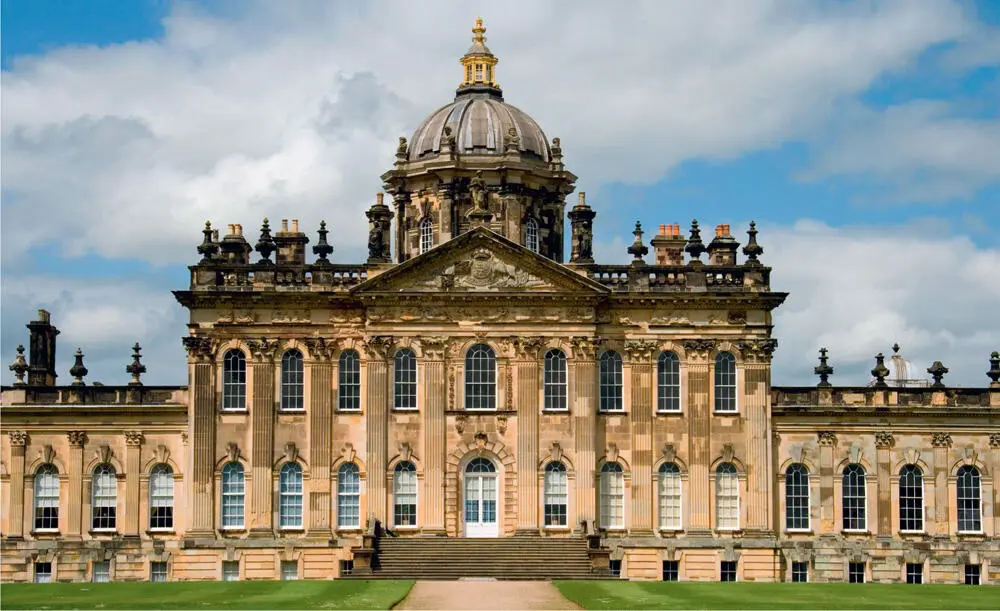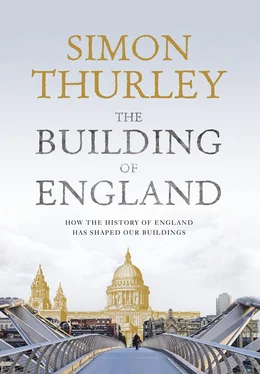The search for the origins of English buildings designed in a style known as Modern has been even more distorting. Knowing that, after the Second World War, the Modern movement had a significant impact on English building, elements in buildings as early as the 1870s are seized upon as precursors. Although a very small number of mainly foreign architects built Modern buildings in England from the 1920s, these buildings have come to form part of the main narrative of English architecture, and the overwhelming mass of other fine and important buildings from the inter-war period is either ignored or deprecated. 7

Somerset House, London. Neo-palladian or neo-Classical? A nicety or a fundamental question?
The sensible solution is therefore to put to one side stylistic labels, most of which are relatively recent inventions and few of which would have been recognised by those contemporary to what is being labelled, and start again. But as historians need to label things, because that is how they communicate and make sense of the past, an alternative strategy is needed. An answer may lie in a different approach: periodisation.
This is, however, another minefield. Historical periods are, of course, an alternative way of characterising what happened in order to make sense of the past. At one level they are self-explanatory, so people will have an idea about the Iron Age, the Romans, the Saxons and the Normans simply on account of the name (although not everyone can remember in which order they came). British scholars, uniquely in Europe, use royal dynasties to describe periods in their history. Plantagenet, Tudor, Stuart, Georgian and Victorian reflect changes in dynasty but they tell us very little else in historical terms. The fact is that dynastic changes rarely represented moments of meaningful architectural change. Even the most famous and apparently absolute dynastic division in English history, the Norman Conquest of 1066, did not represent an architectural break. It would also be hard to argue that anything architecturally decisive took place in either 1485 or in 1603, two of the most frequently used dynastic-break dates in English history. This, of course, is not to say that changes of monarch might not run parallel to architectural changes. The death of the military-minded Conqueror and the accession of William Rufus; the Restoration of Charles II after the Commonwealth; the accession of Edward VII after the long late Victorian years – all of these led, to a lesser or greater extent, to an outbreak of architectural exuberance.
For the same reason that we have to reject dynastic change as a basis for periodising English building we must also reject a rigid calendrical method. Although the unit of a numbered century is easily comprehended, it makes even less sense as a basis for explaining things than the period of rule of a family of kings or queens. Nothing particularly significant happened in 1500, 1600 or 1700 – there is no reason why it should have. The challenge is to try and divide up the story of building in England in such a way that each chunk makes better sense of what was happening. Readers will decide whether my divisions have made understanding English building easier or whether they only confuse it. Obviously, I hope that my divisions help to shed light on why things happened.

Castle Howard, the breathtaking Yorkshire country house chosen as both the television and film setting of Evelyn Waugh’s 1945 novel Brideshead Revisited . Nostalgia, fiction and aesthetics combine to give undue architectural influence to such buildings.
But, alas, there is another pitfall. Architectural change does not take place evenly across time, geography or building type, so chronological divisions will only ever be a rough guide to what took place. This is particularly problematic in this book, which considers a much broader spectrum of building types than is usual. The study of buildings has long been divided up into the separate analysis of churches, castles, industrial archaeology, engineering, country houses, urban studies and vernacular architecture. Archaeology, of fundamental importance for understanding the built world, exists in an even more discrete enclave. Studying individual building types – or even sub-sets of them – as separate disciplines necessarily limits a discussion on the cross-currents between them; more seriously, it fragments the visual and spatial world in which our ancestors actually lived. Distinct disciplines are certainly important – we need people who have a deep understanding of lap joints in 12th-century timber buildings as much as we need those who can spot the derivation of a particular type of Corinthian capital. But we also need synthesis; someone who tries to link up James Wyatt and James Watt.
Much architectural history of the last thirty years has been preoccupied with the study of the country house, to the exclusion of other building types. The country house has sometimes been portrayed as a national driver of innovation, and more pages of English architectural history have been devoted to the development of this single building type than to any other – indeed, it has sometimes been claimed as Britain’s unique cultural contribution to European art. There are reasons for this, of course, not least the enormous success of the National Trust with, at the time of writing, its four million members. But it must be doubted whether the country house really deserves such lopsided attention. Most of the key developments, in fact, took place in an urban context, as this book will argue.
Another area to gain disproportionate attention is the careers of famous architects. Architectural history has too often been about the study of architects, while the role of patrons has consistently been underestimated. This is, in part, perhaps because architectural history was at first written by architects. Indeed, it was not until very recently – and only in specific cases – that the design and construction of a building were handed over to a design supremo who would relieve the patron of almost all input into the structure. Patrons from Benedict Biscop in the 7th century, through Archbishop Lanfranc in the 11th, Lord Burghley in the 16th to William Beckford in the 18th all exercised decisive design influence over their buildings. Innovation might be laid at the feet of a designer but it is just as likely to have originated from a patron who was better read, more widely travelled, and who had seen and experienced many more different types and styles of building.
Designers of buildings before the 1750s had either risen up through the building and craft trades or had come to design through gentlemanly curiosity. But into the 19th century the size and complexity of building construction demanded a spectrum of skills that these traditional routes did not permit. Three branches emerged – architect, engineer and contractor – and, of these, architects have dominated the history books. 8Yet builders, engineers and, indeed, manufacturers can all claim credit for having formed the built environment of England after 1800. In fact, architects have rarely been the sole force in the design of a building; perhaps their only period of absolute ascendency was between the mid 1950s and the late 1970s, a period outside the scope of this book. 9
Excessive interest in famous architects and their oeuvres prevents us from acquiring a rounded picture of what was built and what was important. A good instance of this is the way in which Sir Christopher Wren has come completely to eclipse his contemporaries by having designed palaces, public buildings, churches and cathedrals – the traditional diet of the art historian. Most people have never heard of Wren’s brilliant and distinguished contemporaries Edmund Dummer and Michael Richards, both of whom were very considerable designers responsible for works of equal skill and novelty; unfortunately for their posthumous reputations, they built in naval dockyards and military enclaves, and most of their buildings do not survive. 10
Читать дальше














